Knee bursitis is a common condition that can cause pain and swell in the knee. It is often caused by overuse or repetitive movements and can be very painful. In this blog post, we will discuss knee bursitis recovery time quickly and safely. We will also provide tips for preventing future episodes of bursitis.
Contents
What Is Knee Bursitis
An extremely painful ailment that affects the knee joint is knee bursitis. It’s also as “housemaid’s knee” or “clergyman’s knee,” among other names. In essence, it is an inflammation of one of your knees’ bursae.
Bursae are sacs that lubricate and cushion our joints as they move. A bursa’s principal job is to lessen friction between nearby moving structures. Bursae are typically seen around big joints such as in the shoulder, knees, hip, and elbows. Bursitis is the swelling of this fluid-filled structure. Among the common causes of inflammation include trauma, infection, misuse, and bleeding.
Types Of Knee Bursitis
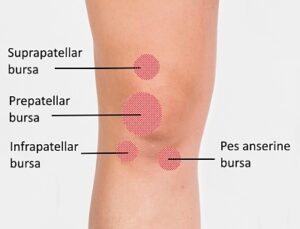
Bursae that form around the patella and those that form elsewhere can both develop around the knee. Prepatellar, superficial, and deep infrapatellar, as well as suprapatellar, bursae are located surrounding the patella. The iliotibial, tibial, and fibular collateral ligament bursae, as well as the gastrocnemius-semimembranosus bursa, are among the bursae that are not anatomically close to the patella.
Three Bursae That Can Commonly Become Irritated Are:
Bursa Prepatellar
( located above the kneecap.)
Prepatellar bursitis is found more in people who kneel as their bursitis gets inflamed such as plumbers, carpet installers, and gardeners.
Bursa Infrapatellar
(located below the kneecap.)
Infrapatellar bursitis frequently results in pain immediately behind the kneecap. The infrapatellar bursa is frequently irritated by repeated jumping.
Suprapatellar Bursa
(located above the kneecap.)
Acute trauma or recurrent microtrauma can cause suprapatellar bursitis. It can also be caused by direct trauma from falls and overuse of the bursa can cause more serious instances.
What Causes Knee Bursitis?
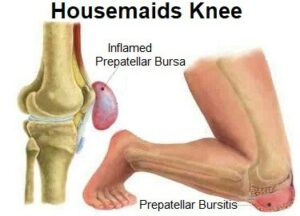
- A heavy blow injury, such as one sustained during a fall.
- Irritation is caused by excessive pressure or friction.
- Additionally, German-like bacteria that cause inflammation can enter the bursa.
- Bursitis can occasionally develop when inflammatory conditions like gout and rheumatoid arthritis expand to the bursa.
- Some occupations are linked to an increased incidence of bursitis. Installers of tiles are a typical example. Kneeling on a hard floor while working there is common.
- Carpenters, housekeepers, roofers, and gardeners are some more high-risk professions.
- Long computer sessions and some sports, including volleyball, may potentially increase your risk of developing bursitis.
Symptoms
When irritated, the bursa increases in fluid accumulation. The condition is known as effusion. Particularly if the inflamed bursa is directly beneath the skin, this results in swelling that is visible and palpable from the outside. When the swollen area is at rest, it hurts, but moving it or applying pressure to it from the outside hurts it more than when it is at rest. Sometimes it appears red and heated as well. Additionally, you can get a temperature and feel generally sick.
How To Diagnose Knee Bursitis
Your physiotherapist will use a complete physical examination and a full medical history to make the initial diagnosis of knee bursitis.
If your doctor suspects an infection, they could arrange for an aspiration of the bursa fluid to be removed and tested.
Ways To Recover Knee Bursitis
Knee bursitis has many management options. Conservative treatment usually includes rest, ice, and anti-inflammatory medication. Physical therapy can also be helpful for rehabilitation by strengthening the surrounding muscles to alleviate stress on the bursa. Depending on its severity, the doctor will choose surgery or another mode of recovery.
Let us discuss the different ways to manage knee bursitis below:
Pharmacological Recovery
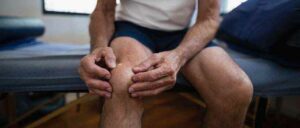 Most bursa instances will be treated with medicines to control pain and swelling. However, antibiotics are required to treat septic bursitis in order to eradicate the infection.
Most bursa instances will be treated with medicines to control pain and swelling. However, antibiotics are required to treat septic bursitis in order to eradicate the infection.
Nsaids, non-steroidal anti-inflammatory (NSAIDs)
NSAIDs lessen pain and swelling associated with bursitis. Ibuprofen or naproxen are frequently used to treat knee bursitis . Because they prevent blood from clotting properly, NSAIDs might not be suitable for all persons.
Corticosteroids
To quickly reduce swelling and relieve discomfort, deep bursitis may require treatment with a corticosteroid injection, such as methylprednisolone or cortisone. The doctor could drain part of the bursa’s fluid before injecting the corticosteroid to lessen swelling.
Antibiotics
To quickly reduce swelling and relieve discomfort, deep bursitis may require treatment with a corticosteroid injection, such as methylprednisolone or cortisone. The doctor could drain part of the bursa’s fluid before injecting the corticosteroid to lessen swelling.
Surgical Recovery
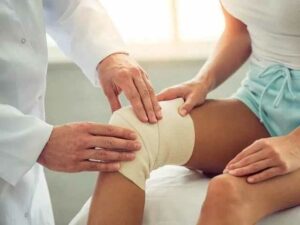 When conservative treatments have failed for chronic/ post-traumatic knee bursitis, outpatient arthroscopic bursectomy under local anaesthesia is an effective procedure. Knee Bursitis can be cured through surgery, depending on the severity of the condition and other factors, such as diagnosis and age.
When conservative treatments have failed for chronic/ post-traumatic knee bursitis, outpatient arthroscopic bursectomy under local anaesthesia is an effective procedure. Knee Bursitis can be cured through surgery, depending on the severity of the condition and other factors, such as diagnosis and age.
The surgery treatment includes:
-Removing the affected bursa tissue allows your body to form a new, healthy bursa.
-Repairing or reconstructing any damaged knee structures such as ligaments and/or cartilage.
-Reactivating or strengthening the surrounding muscle groups through rehabilitation exercises.
Physical Therapy Recovery
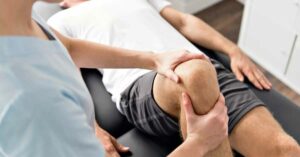
- The RICE approach (rest, ice, compression, and elevation) cures prepatellar bursitis. The so-called “rest phase” is a brief time of inactivity. The first few days following the trauma should be the extent of this time. Resting will lessen the metabolic demands on the wounded tissue and prevent a rise in blood flow. Additionally, the pain will lessen as a result of rising threshold levels caused by cold in synapses and free nerve terminals.
- Keep the ice off your knee for a short period of time (maximum 20 minutes at a time). The compression will lessen swelling by reducing the intramuscular blood supply to the injured area. Additionally, this aspect of the Rice-principle lowers the pressure in nearby blood arteries and aids in preventing excessive bleeding. However, no randomised clinical investigation has ever demonstrated the efficacy of the RICE approach.
- Once the initial inflammation has subsided, a programme of stretching and gentle strengthening will be started to restore complete motion and enhance strength to lessen stress on the tendons and knee joint. Knee strengthening and stretching exercises for therapeutic purposes. The quadriceps’ static contraction is included in this. The patient should be able to perform this exercise at home one to three times per day.
- The goal of the rehabilitation process is to allow the patient to resume regular activities. Put your fingertips on the inner side of the quadriceps to check the effectiveness of the exercise; you should feel the muscle contract as you do. The exercise is to hold the contraction for 5 seconds, for at least 10 times as forcefully as possible. It’s critical to remember that this practice needs to be painless.
- Additionally, stretching the quadriceps is a beneficial exercise for the patient since it eases friction between the patella tendon and the skin. As the patella tendon becomes more flexible, friction decreases. The patient can also benefit from the physiotherapist’s use of electrotherapy techniques and instruction on the use of knee pads for kneading exercises.
Conclusion
While recovering from knee bursitis can be a lengthy process, by following these tips you can minimize the amount of time it takes to feel better and return to your normal activities. If at any point in your recovery you experience pain or discomfort that does not go away with rest or home treatment, be sure to consult your doctor right away for further guidance.
Physical Therapy help patients recover from pain. If you’re experiencing Back pain, Shoulder pain, Knee pain, Neck pain, Elbow pain, Hip pain, or Arthritis pain, a physical therapist at MantraCare can help: Book a physiotherapy session.


